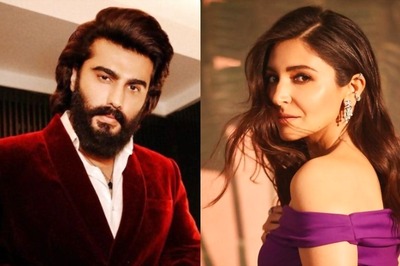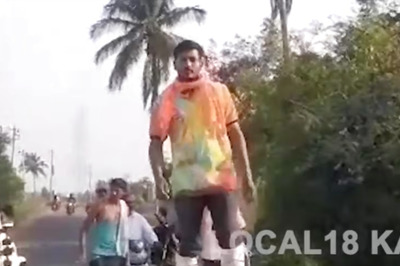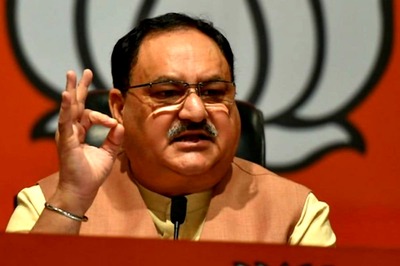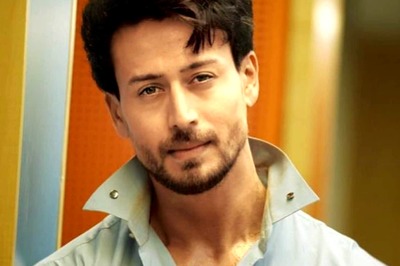
views
On the eve of International Indigenous People’s Day, people from the Scheduled Tribes of India held a press conference that had no takers from mainstream media. While organizing a press conference which involves booking a suitable venue and getting a positive response from mainstream national media can be quite cumbersome indeed, the task seems almost impossible for the tribal people of this country.
The United Nations, in 1994, had declared August 9 as International Indigenous People’s Day. To commemorate the 24th anniversary of the day, All Adivasi Delhi – NCR had organised a press conference in the capital to apprise the media about the social, economic and cultural condition of tribals in India.
Eminent personalities like JawaharLal Nehru University Teachers’ Association president Prof. Sonia Jharia, Former Planning Commission member C K Tirki, Geo – Scientist of Govt. of India Dr. Ashok Baxla, Advocate Nicholas Barla, Social Scientist Dr. A. Benjamin and Research Scholar on Tribal Affairs Dr. Vincent Ekka were present to address the conference.
However, such was the neglect from mainstream media that none of their representatives, even after one hour’s wait, turned up for the event. Compelled by the situation, the organisers, who had expected the interaction to go on for at least 2 hours, commenced the conference and called it off after the no-show.
In fact, the commencement of the press conference was initially delayed as some of the reporters of television channels told the organisers that they were on the way and would reach soon. But their journey never culminated as all of them miraculously failed to locate the quite well – known venue.
Ironically, as many as 17 cameras from different television channels were present just few meters away from Constitution Club for another press conference at Press Club of India. The All Adivasi Delhi – NCR had also tried to book Press Club for the press conference, ten days before the event, only to be turned down.
The painful saga of this press conference reveals the apathy of mainstream media toward tribal populations and their issues.
Altogether 90 media organisations were informed well in advance for this press conference, which was eventually held at the Constitution Club of India. E-mails were sent to at various media organisations, requesting them to cover it.
Several journalists had been personally informed about the conference. Dr. Ashok Baxla, who works with Govt. of India as a Geo – Scientist, told that this is not the first time when mainstream media has ignored tribals. He enumerated several stories how mainstream media ignored agitations, demonstrations and other programmes of tribal people in the past. He regretted that “mainstream media doesn’t find anything attractive to us as we don’t carry a glamorous look. We don’t match to their expectations perhaps.”
Blaming the government for the media neglect, social scientist Dr. A. Benjamin said that the Indian government did not want to give tribals the status of Indigenous People as prescribed by the United Nations. Even census data relating to tribals is whimsically manipulated. He further informed that there are around 8 – 9 lakhs tribals in Delhi itself, but the column of Scheduled Tribes is left blank here during the Census. Tribals are not given the status of Scheduled Tribes in Delhi.
Former Planning Commission member C K Tirki expressed his anguish by saying that for the mainstream media, a tribal person is like a poor cyclist on the road who is destined to be crushed.
A cameraperson, from an agency called Byte Collector, mustered some courage to stay for few minutes in this press conference and then left hurriedly. Sometime during the course of the short interaction, a complaint, disguised as a question was shot from the last row - What do tribal organisations do when a person is declared a traitor for writing on tribals’ plights?
Replying to the question, Prof. Sona Jharia expressed the helplessness of the tribal people by saying that they are fighting for their own survival. They are suppressed and divided at every level. In such a scenario, what can they do for anybody as they themselves are so vulnerable? This was the only question that was asked during the conference.
The presence of central Indian tribals in India mainstream media is almost negligible. It was evident from a survey carried out in 2006 that out of 20 top posts in the editorial department of national mainstream media, none was occupied by a person belonging to Scheduled Tribes.
Arun Oraon, a research scholar of JawaharLal Nehru University, recounted an old memory when an influential person (from the editorial department of a news channel that claims to be the largest channel of the nation) had advised the former to join the Indian Army rather becoming a journalist. Arun had at the time been interning with the channel after passing out with a journalism degree from the Indian Institute of Mass Communication (IIMC), a premier institute of journalism in the country. Arun failed to find a suitable job in any mainstream media organistion.
It was Arun who tried to book Press Club of India first for the press conference. Once his request was turned down, he approached Kerala House for this. Authorities at Kerala House too disappointed him.
It’s a rare occasion in Delhi when the representative organisation of tribal people invites mainstream media to apprise about their plights and conditions. And even United Nations cannot help shed any light in this abject passivity.
(The author is a senior journalist. Views expressed are personal.)




















Comments
0 comment